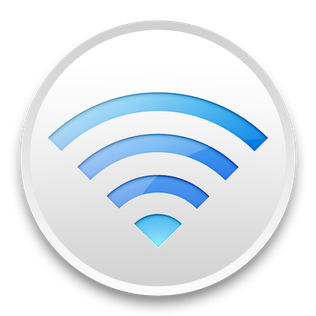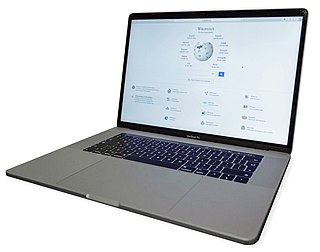
AirPort is a discontinued line of wireless routers and network cards developed by Apple Inc. using Wi-Fi protocols. In Japan, the line of products was marketed under the brand AirMac due to previous registration by I-O Data.
Apple Inc. has sold a variety of LCD and CRT computer displays since introducing their first display in 1980. Apple paused production of their own standalone displays in 2016 and partnered with LG to design displays for Macs. In June 2019, the Pro Display XDR was introduced, however it was expensive and targeted for professionals. In March 2022, the Studio Display was launched as a consumer-targeted counterpart. These are currently the only Apple-branded displays available.

The Apple Cinema Display is a line of flat-panel computer monitors developed and sold by Apple Inc. between 1999 and 2011. It was initially sold alongside the older line of Studio Displays, but eventually replaced them. Apple offered 20, 22, 23, 24, 27, and 30-inch sizes, with the last model being a 27-inch size with LED backlighting.

The MacBook Pro is a line of Mac laptops made by Apple. Introduced in January 2006, it is the higher-end lineup in the MacBook family, sitting above the consumer-focused MacBook Air. It is currently sold with 14-inch and 16-inch screens, all using Apple silicon M-series chips.

The MacBook is a line of Mac laptops sold by Apple Inc. between May 2006 and February 2012. It replaced the iBook series of notebooks as a part of Apple's transition from PowerPC to Intel processors. Positioned as the low end of the MacBook family, below the premium ultra-portable MacBook Air and the performance-oriented MacBook Pro, the MacBook was aimed at the consumer and education markets. It became the best-selling Mac in Apple's history. For five months in 2008, it was the best-selling laptop of any brand in US retail stores.

MagSafe is a series of proprietary magnetically attached power connectors developed by Apple Inc. for Mac laptops. MagSafe was introduced on 10 January 2006, in conjunction with the MacBook Pro, the first Intel-based Mac laptop, at the Macworld Expo. A MagSafe connector is held in place magnetically so that if it is tugged, it will be pulled out of the port without damaging the connector or the port, and without pulling the computer off its surface. A thinner and wider version, called MagSafe 2, was introduced in 2012. It was discontinued across Apple's product lines between 2016 and 2019 and replaced with USB-C. MagSafe returned to Mac laptops with the introduction of updated MacBook Pro models with MagSafe 3 in 2021.

Target Disk Mode is a boot mode unique to Macintosh computers.

The Intel-based iMac is a discontinued series of Macintosh all-in-one desktop computers designed, manufactured, and sold by Apple Inc. from 2006 to 2022. While sold, it was one of three desktop computers in the Macintosh lineup, serving as an all-in-one alternative to the Mac Mini, and sat below the performance range Mac Pro. It was sold alongside the Xeon-based iMac Pro from 2017 to 2021.

The MacBook Air is a line of laptop computers developed and manufactured by Apple since 2008. It features a thin, light structure in a machined aluminum case and currently either a 13-inch or 15-inch screen. The MacBook Air's lower prices relative to the larger, higher performance MacBook Pro have made it Apple's entry-level notebook since the discontinuation of the original MacBook line in 2011.

MacBook is a brand of Mac notebook computers designed and marketed by Apple that use Apple's macOS operating system since 2006. The MacBook brand replaced the PowerBook and iBook brands during the Mac transition to Intel processors, announced in 2005. The current lineup consists of the MacBook Air (2008–present) and the MacBook Pro (2006–present). Two different lines simply named "MacBook" existed from 2006 to 2012 and 2015 to 2019. The MacBook brand was the "world's top-selling line of premium laptops" as of 2015.

The Mini DisplayPort is a miniaturized version of the DisplayPort audio-visual digital interface.
Thunderbolt is the brand name of a hardware interface for the connection of external peripherals to a computer. It was developed by Intel in collaboration with Apple. It was initially marketed under the name Light Peak, and first sold as part of an end-user product on 24 February 2011.

The 12-inch MacBook is a discontinued Mac laptop made by Apple Inc., which sat between the MacBook Air and MacBook Pro in Apple's laptop lineup.

The iPad Pro is a series of tablet computers, positioned as a premium model of Apple's iPad tablet computer. It runs iPadOS, a tablet-optimized version of the iOS operating system.

The Pro Display XDR is a 32-inch flat panel computer monitor created by Apple, based on an LG supplied display, and released on December 10, 2019. It was announced at the Apple Worldwide Developers Conference on June 3, 2019 along with the third-generation Mac Pro. It is the first Apple-branded display since the Apple Thunderbolt Display was discontinued in 2016. "XDR" stands for "Extreme Dynamic Range." It is sold alongside the consumer Apple Studio Display.

The fifth-generation iPad Pro, colloquially known as the M1iPad Pro, is a line of iPad tablet computers developed and marketed by Apple Inc. It was announced on April 20, 2021, and was available in 11-inch (28 cm) and 12.9-inch (33 cm) screen size options, which are the same as its predecessor, the iPad Pro. Preorders began on April 30, 2021, and the product was released worldwide on May 21, 2021. It comes in two colors: Silver and Space Gray.

The Intel-based MacBook Air is a discontinued line of notebook computers developed and manufactured by Apple Inc. from 2008 to 2020. The Air was originally positioned above the previous MacBook line as a premium ultraportable. Since then, the original MacBook's discontinuation in 2011, and lowered prices on subsequent iterations, made the Air Apple's entry-level notebook.

The MacBook Pro with Apple silicon is a line of Mac notebook computers first introduced in November 2020 by Apple Inc. It is the higher-end model of the MacBook family, sitting above the consumer-focused MacBook Air, and is currently sold with 14-inch and 16-inch screens. All models use Apple-designed M-series systems on a chip.

The Intel-based MacBook Pro is a discontinued line of Macintosh notebook computers sold by Apple Inc. from 2006 to 2021. It was the higher-end model of the MacBook family, sitting above the consumer-focused MacBook Air, and was sold with 13-inch to 17-inch screens.

The Apple Studio Display is a 27-inch flat panel computer monitor developed and sold by Apple Inc. It was announced on March 8, 2022, alongside the Mac Studio desktop, and was released on March 18, 2022. It is Apple's consumer display, sitting below the Pro Display XDR.
















